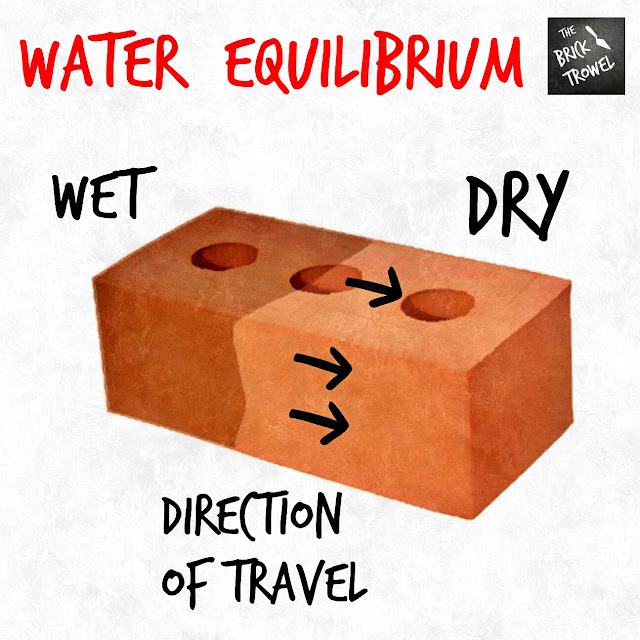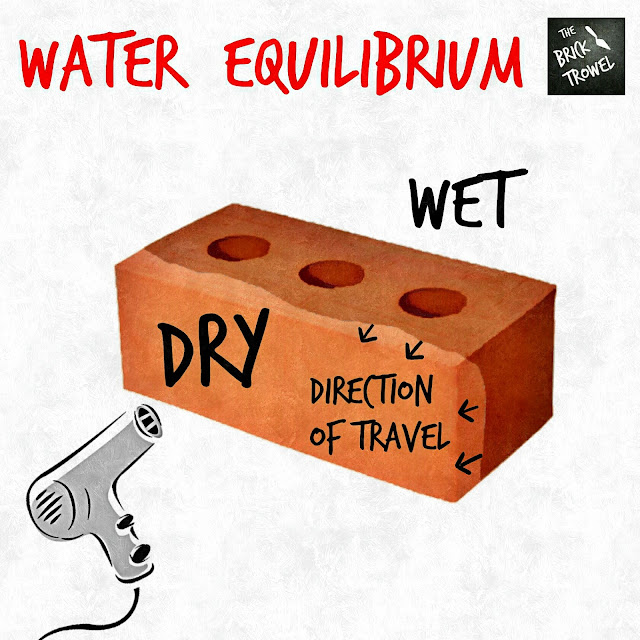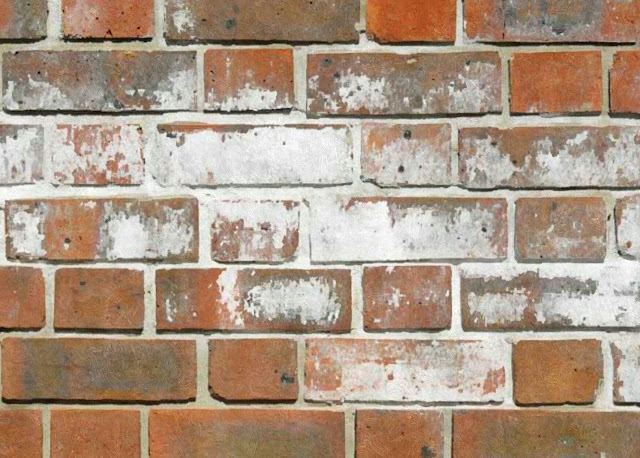Do your clay bricks or concrete blocks have white powdery stains weeping out of them? This is a common problem known as Efflorescence. Here is a simple guide to understanding how efflorescence works, how to clean it off masonry and how to fix any underlying problems to stop it returning.
You can recognize efflorescence because it will disappear while the masonry wall is wet and then reappear as it dries. Also when you scratch it off the wall it becomes a powder like substance, this makes it easy to differentiate from organic staining like mold.
Efflorescence put simply is salt that has been carried to the surface of masonry by water. Salts are found in cement, and also clay bricks. When water travels through the masonry, it carries the salt to the surface. The water then drys up leaving the white salt stain.
These salts are soluble, meaning they dissolve when in contact with water and are held in the water.
Think about what happens to sugar after you have stirred it into a cup of tea. The sugar is still in the tea but it has dissolved. This is because sugar is made up of salts that are soluble.
For example imagine one half of a brick was wet and the other half was dry. The moisture from the wet side will be pulled over into the dry side as water is trying to achieve a balanced saturation.

This time imagine the whole brick is saturated. Because it is already in equilibrium the water has no where to travel. However if you were to use a hair dryer on the face side of the brick it will start to evaporate the water.
Keep your bricks covered from the rain. This is probably the most important thing a bricklayer can do. If bricks or blocks are on the construction site on wrapped pallets, keep them wrapped until you need them. Keep your brick stacks covered overnight or when it's raining. Unfinished walls should have their tops covered so water doesn't get inside.
Having a few good tarpaulins is important.
You can recognize efflorescence because it will disappear while the masonry wall is wet and then reappear as it dries. Also when you scratch it off the wall it becomes a powder like substance, this makes it easy to differentiate from organic staining like mold.
Key questions answered:
- What is efflorescence and why does it happen?
- How does Water travel to the face of brickwork?
- Can you get rid of Efflorescence from Bricks?
- Where does the water come from?
- Will the Efflorescence go away on it's own?
- How do you clean off Efflorescence from masonry?
- How do you prevent Efflorescence becoming a problem?
What is efflorescence and why does it appear on Masonry?
Efflorescence put simply is salt that has been carried to the surface of masonry by water. Salts are found in cement, and also clay bricks. When water travels through the masonry, it carries the salt to the surface. The water then drys up leaving the white salt stain.
Salts found in Cement and Mortar:
- Potassium Carbonate
- Sodium Carbonate
- Calcium Carbonate
Salts found in Clay Brick:
- Calcium Sulfate
- Vanadyl Sulfate
- Maganese Oxide
These salts are soluble, meaning they dissolve when in contact with water and are held in the water.
Think about what happens to sugar after you have stirred it into a cup of tea. The sugar is still in the tea but it has dissolved. This is because sugar is made up of salts that are soluble.
Why does the water travel or migrate to the surface of the brickwork?
Water loves to travel, also called wicking through capillary action. This is because it is always trying to reach a state of equilibrium.For example imagine one half of a brick was wet and the other half was dry. The moisture from the wet side will be pulled over into the dry side as water is trying to achieve a balanced saturation.

This time imagine the whole brick is saturated. Because it is already in equilibrium the water has no where to travel. However if you were to use a hair dryer on the face side of the brick it will start to evaporate the water.
As soon as the face side becomes less saturated than the rest of the brick the water will start traveling there to reach equilibrium.

This last scenario is normally what happens on a brick wall. Because the face side of the wall will receive the sun and air movement, any water held in the bricks or behind them will start to travel to the face as it drys. Picking up the salts and transporting them there as well.
Yes you can.
The water can come from many sources. Here are some of the most common places you should investigate:
If you get a lot of rain or snow melt in your area, the masonry could absorb the water. Check if the area of brickwork that has the efflorescence marks is a somewhere that gets hit by a lot of rain. Normally on a house this will only be on one or two sides and will be lower on the wall. Any bricks that have exposed core holes and can fill with water are also prone to efflorescence.
Sometimes water pipes can get small holes in them that will leak down the inside of your walls. This should be quite easy to recognize. The wet bricks will be a distinct patch on the wall and there should be additional water damage within the house.
If flashing are not fitted properly or have become damaged they can cause rain water to leak down the masonry. Check areas common for flashing failures, around windows and doors, also where brickwork becomes another cladding material.
Because bricks and blocks are porous, if they are left out in the weather before they are laid, they will hold a lot of water. Once they are in the wall the water will migrate out. The efflorescence will begin to show a few days after being laid and will normally affect large portions of the wall.
Soil can easily transfer moisture into masonry. Concrete cinder blocks are often used for building retaining walls. If the earth has been filled up hard against it with no waterproofing membrane, moisture will travel through. On a brick wall sometimes footings or foundations can be below ground level. Just make sure it's not in contact with the first course of bricks.
Concrete fill used for reinforcing has high volumes of water in it. Cinder blocks commonly get filled with concrete as does some structural brickwork, for example brick pillars or piers. The water in the concrete filling can work it's way into the masonry.

This last scenario is normally what happens on a brick wall. Because the face side of the wall will receive the sun and air movement, any water held in the bricks or behind them will start to travel to the face as it drys. Picking up the salts and transporting them there as well.
Can you get Rid of Efflorescence on Brickwork?
Yes you can.
Efflorescence depends on 3 Conditions:
- Soluble Salts in the brickwork
- Water in the brickwork
- The ability for the water to travel
Where does the water come from?
If your brickwork has a problem with efflorescence this is the most important question you can ask.The water can come from many sources. Here are some of the most common places you should investigate:
- Rain / Snow Melt
- Leaking Pipe
- Leaking Flashing
- Brick were Wet when Laid
- Masonry contact with the Ground
- Masonry contact with Concrete Reinforcement
1) Rain / Melting Snow
If you get a lot of rain or snow melt in your area, the masonry could absorb the water. Check if the area of brickwork that has the efflorescence marks is a somewhere that gets hit by a lot of rain. Normally on a house this will only be on one or two sides and will be lower on the wall. Any bricks that have exposed core holes and can fill with water are also prone to efflorescence.
2) Leaking Pipe
Sometimes water pipes can get small holes in them that will leak down the inside of your walls. This should be quite easy to recognize. The wet bricks will be a distinct patch on the wall and there should be additional water damage within the house.
3) Leaking Flashing
If flashing are not fitted properly or have become damaged they can cause rain water to leak down the masonry. Check areas common for flashing failures, around windows and doors, also where brickwork becomes another cladding material.
4) Bricks were Wet when Laid
Because bricks and blocks are porous, if they are left out in the weather before they are laid, they will hold a lot of water. Once they are in the wall the water will migrate out. The efflorescence will begin to show a few days after being laid and will normally affect large portions of the wall.
5) Masonry is in Contact with the Ground
Soil can easily transfer moisture into masonry. Concrete cinder blocks are often used for building retaining walls. If the earth has been filled up hard against it with no waterproofing membrane, moisture will travel through. On a brick wall sometimes footings or foundations can be below ground level. Just make sure it's not in contact with the first course of bricks.
6) Masonry Contact with Concrete Reinforcement Filling
Concrete fill used for reinforcing has high volumes of water in it. Cinder blocks commonly get filled with concrete as does some structural brickwork, for example brick pillars or piers. The water in the concrete filling can work it's way into the masonry.
How you fix your efflorescence problem will be based on you accurately identifying the source of water. If you are struggling to do so, I would recommend getting in a professional bricklayer to have a look.
This depends on the source of the water. If your masonry has just been built, chances are that the bricks were a bit wet and any efflorescence will disappear on it's own. It can take up to a year, however you can clean it off, see how below.
If you think the source of moisture is rain pooling, a leaking pipe or flashing, or masonry that is in contact with the ground, (in other words, water that will continue to get into the brickwork or masonry) efflorescence likely won't go away on it own. In fact even if you were to clean it off, it will return. It would be best to get a professional in to fix the underlying problem.
If you don't want to wait for the efflorescence to disappear on it's own, you can get rid of the white staining yourself.
First of all have a go at dry scrubbing the efflorescence powder off. Often just a strong brush is enough to remove the salts from the surface of the brick. It also means no more water needs to be added to the wall.
If the efflorescence staining is more stubborn use Muriatic Acid (hydrochloric acid).
Will the White Efflorescence Stains go away with Time?
This depends on the source of the water. If your masonry has just been built, chances are that the bricks were a bit wet and any efflorescence will disappear on it's own. It can take up to a year, however you can clean it off, see how below.
If you think the source of moisture is rain pooling, a leaking pipe or flashing, or masonry that is in contact with the ground, (in other words, water that will continue to get into the brickwork or masonry) efflorescence likely won't go away on it own. In fact even if you were to clean it off, it will return. It would be best to get a professional in to fix the underlying problem.
How to Clean off Efflorescence from Brickwork - DIY
First of all have a go at dry scrubbing the efflorescence powder off. Often just a strong brush is enough to remove the salts from the surface of the brick. It also means no more water needs to be added to the wall.
If the efflorescence staining is more stubborn use Muriatic Acid (hydrochloric acid).
Check out the Price here
Make sure you wear protective clothing, and dilute to the recommended ratio (normally around 30%). Brush the acid on to the wall with a hard brush and let it sit for 20 minutes. Next scrub a mildly diluted detergent over the wall to neutralize the acid, and then rinse well with a hose.
Make sure you wear protective clothing, and dilute to the recommended ratio (normally around 30%). Brush the acid on to the wall with a hard brush and let it sit for 20 minutes. Next scrub a mildly diluted detergent over the wall to neutralize the acid, and then rinse well with a hose.
Bricklaying Tips to Stop Efflorescence becoming a problem
The best way to stop efflorescence forming, is to not let it develop in the first place. The bricklayer has the responsibility to do everything they can to mitigate efflorescence. Proper training is therefore essential. Here are a few things for a bricklayer to put in place.Keep your bricks covered from the rain. This is probably the most important thing a bricklayer can do. If bricks or blocks are on the construction site on wrapped pallets, keep them wrapped until you need them. Keep your brick stacks covered overnight or when it's raining. Unfinished walls should have their tops covered so water doesn't get inside.
Having a few good tarpaulins is important.
12' x 25' Heavy Duty Poly Tarp
Any masonry fencing or pillars should have a proper capping to stop water getting in. Brick veneers need adequate ventilation and drainage. This will keep the cavity nice a dry.
If there is any chance water can transfer from the ground into the brickwork or masonry make sure you use a moisture barrier.
Putting into place these basics will minimize the risk of efflorescence developing on your bricks.
If there is any chance water can transfer from the ground into the brickwork or masonry make sure you use a moisture barrier.
Putting into place these basics will minimize the risk of efflorescence developing on your bricks.



